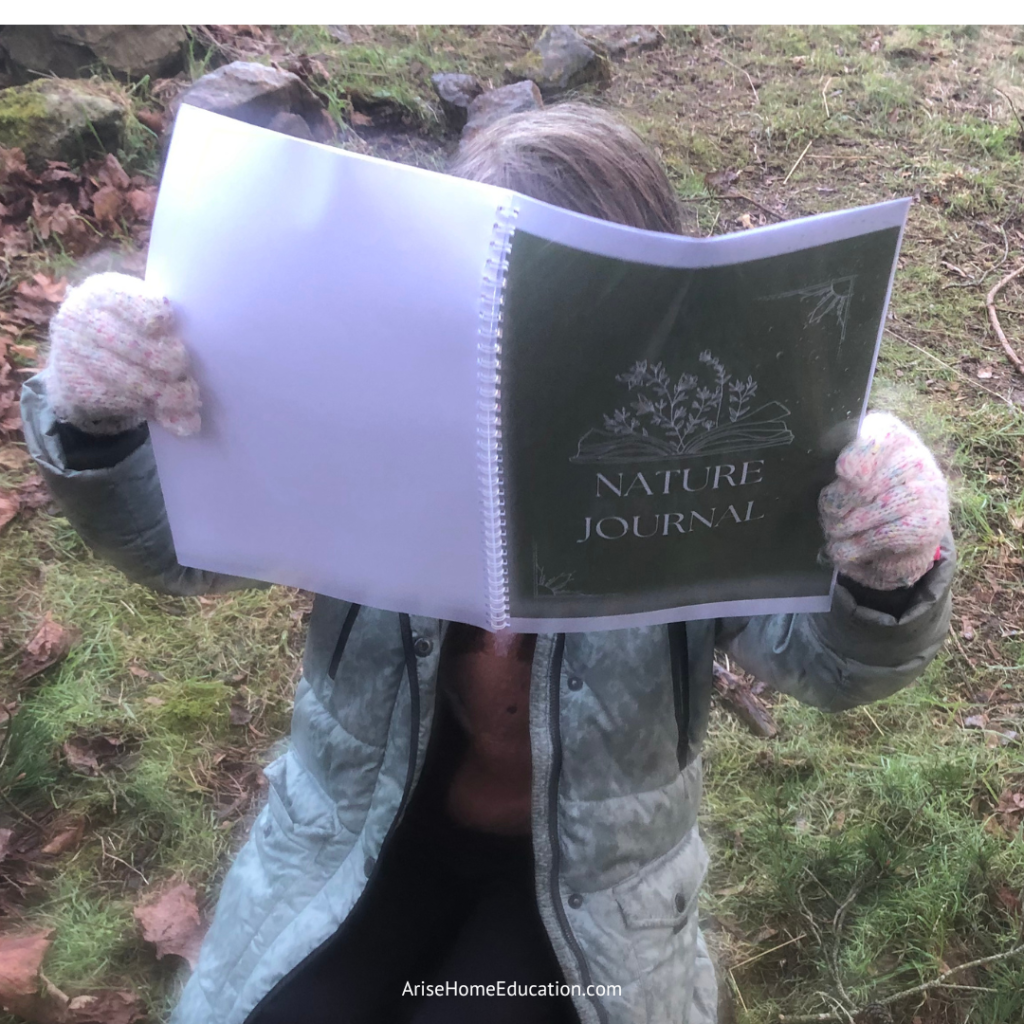Get started with nature study with this nature journal for kids. Make your time exploring outside count as a homeschool science lesson.

It is pretty conclusive that time outside in nature is good for children and adults alike! Countless studies have been done looking at the benefits to us all as humans. These benefits are mental, physical, spiritual, developmental as well as academic. Children who spend time outside regularly learn better, have better physical health, lower obesity levels, as well as better mental health.
For many home educators, this will come as no surprise, especially if you are familiar with Charlotte Mason’s educational philosophy. Nature study is a cornerstone of her educational approach. Famously, she recommended children spend 4-6 hours outdoors every day! For better contextulisation of that statement, Miss Mason lived and worked in the north-east of England in the Lake District, famous for its rainy weather, so she did not think poor weather conditions should stand in the way of a child being outdoors.
“Never be within doors when you can rightly be without”
– Charlotte Mason (V1. p42)
How to use a nature journal for kids
Nature Study is about more than acquiring knowledge about nature and biology. It is about infusing a love of creation, and learning to be still and observe. Charlotte Mason encourages parents to make nature study something that is a joy. Therefore, allow the child to observe (and take notes in a special nature journal for kids).
For younger children, begin small. This might be a short walk close to home, even through a local park. A great way to help open this door to younger children is through nature scavenger hunts.
Seek to make getting outdoors and using a nature journal for kids a habit. Last year, I began setting Wednesday mornings aside as our nature study time. I made the decision that first thing we would go for a nature walk. We have been using Exploring Nature with Children. This curriculum has a theme for each week. Therefore, I would tell the children what we were looking for that week. If tree week, let’s look at the trees: how do they look? Can we identify any of them? How do they feel when we touch them? The questions were simple, and designed to help them observe.

Visit the same location throughout the seasons
I recommend having a set place, this was a lesson I learned through the 2020-22 lockdown. Since I was a child, I have always loved outdoors and wild places. I grew up climbing trees, and playing in our local river. As an adult, I’m always on the lookout for the next beautiful wild place to explore. Therefore, for years there were a number of different local places we would rotate around to visit, and frequently travel far and wide for a new adventure. However, lockdown brought a fresh perspective.
Being forced to stay local, our daily exercise meant we walked the same stretch of small river, the same woodland, the same hedgerows. March 2020 saw the global shutdown of travel, both domestic and global; but it also saw a glorious spring for the United Kingdom. The weather changed from a very wet, windy, dreary February to weeks of sunshine. And like so many others, I learned to look at the nature on my doorstep with a deeper appreciation.
Nature Study Through The Seasons
Our family watched as the woodland around our home changed from the leafless trees of winter, to the bright, fresh green of spring. We delighted in peering through the bare branches of March to observe our local birds, busily building nests.
So last year, I took my lessons from 2020, and chose our nature spot. We visited the same bit of woodland every Wednesday morning. In doing so we could appreciate the changes that occur week-on-week. We could learn about the species present in that area. The children would find interesting things every week. We’d come home with interesting rocks, pine cones, leaves, and flowers. They would search for living things under rocks, or within rotting wood.
The experience was not only educational. But for us all, it was a time of stillness. The wood on a Wednesday morning was mostly quiet, sometimes we saw no one. We would come home relaxed, ready to learn. If the weather was truly awful I would change the day, as I was doing this with a young baby in tow. But then this is about delight, joy, and doing what is right for your family.

Fun nature journal for kids activities
I know many families will take nature journals, watercolour supplies, field guides, etc. out to their nature walks with them. I have tried this. When my older children were young, I tried this. I tried to have my boys sit nicely in the wood and do watercolour.
Honestly, it ended in one stressed, frustrated mama. A toddler would usually want to disrupt the nature study ideal I was seeking to create.
The boys wanted to climb trees, or ford rivers.
And I sat feeling like a home school failure… because of course nature journaling in nature is the gold standard of home education!
I did try again, with lower expectations, and it was a bit more successful- one child loved it!
So I now keep the nature journaling for when we come home. Sometimes I will bring a field guide with us. However, I know this will be more for my own reference. Therefore, if we are going to look for things I feel less familiar with, then we take a field guide.
keep nature journaling for at home
At home, we keep our nature journals. As we work in our nature journal we do a little sketch, and write about what we have seen. If we have found a particular species of plant, animal, or bird I will bring out the field guide to help them look more closely, and sketch it. You may want to suggest they trace it, and stick the picture into their journal. There is then space for them to write about what they saw, and how they felt. I also encourage them to make observations about the weather.

Nature Journaling for Kids: Prompts
Nature journals for kids do not need to be complicated. An easy way to start is simply a nature notebook, where they comment on their nature experiences. Or if they do not know what to write, try some nature journal prompts:
- How did I feel on my nature walk today?
- What three things did I see which stood out to me?
- What did I hear today?
- Think of the word TREE. Write an acrostic poem.
- From one of the living things observed today, create a food web diagram.
- Write a woodland haiku.
- How were your different senses affected by nature today?
- Considering God’s creation, how did you see God’s glory in his created world today?
- Find five different flowers (or trees, or twigs, or leaves, etc), how are they different?
- For each season, how does it make your wild place feel different?
Older kids can be encouraged to add the scientific names to their nature journal entries. There are also excellent tutorials on YouTube to help them learn watercolour and sketching techniques. Therefore, nature journaling can become an outlet for learning art as well and to develop their artistic skills.
Nature journaling for kids is a creative outlet
As children become familiar with the same area, they will see the life cycle of the seasons: from frogs to the transformation of trees. The connectedness of nature becomes increasingly apparent as the natural world becomes a familiar place. Slowly, you will find your child’s and your own observation skills are honed with time spent in the great outdoors, as well as a love of the outdoors.
Nature journals for kids can become an outlet for creative writing. High school kids may want to read some of the great nature writers, like Annie Dillard, Nan Shepherd, Robert MacFarlane, and Thoreau. Great writers and thinkers will help them not only as writers, lovers of nature, but also as thinkers.
Nature Study Supplies
You do not need to spend large amounts of money. Over time, you can build on what you already have. So do not let a lack of supplies stop you from beginning nature study. To start, just head outside! Talk about what you see with your children. However, there are certain things you will find helpful.
- A nature journal for kids.
- Watercolor paints
- Colored pencils.
- Field Guides – when looking for these, take your time. Try the library first, to see what they have. Look at ones that have clear pictures of what you want to study. Over time build up a home library of different field guides. Also, make sure they are relevant to your region.
- Magnifying glass.
- Binoculars.
Many of these supplies can also be used for studying Astonomy with the Stargazing Natur Journal for Kids.

Miscellaneous Nature Study Ideas
Although I strongly recommend having your familiar nature spot, it is still beneficial to go on nature field trips. Field trips could be further afield with visits to national parks, or nature reserves. Although our regular nature walks are as a family, we sometimes meet with other families as nature friends. This helps if we want to go for a longer hike, or spend a full day outside.
A lovely idea is to create a space in your home to have a nature table. This is a place to show what your child finds. This can change with the seasons. If space does not allow, this could be a space on a bookshelf to show a few small things you have collected, change what you show to reflect the time of year, and the passing of the different seasons.
As a child, I loved pressing flowers. I was given a flower press as a gift, it delighted me. Create a collage of the different plants and flowers around your home. If you do not have a flower press, use heavy books to press flowers. These can be used in a collage or stuck in your own nature journal.
Mark the different seasons by creating a phenology wheel. This is a circle split into the 12 months of the year, where you sketch something defining for that month. This can create a beautiful record of the natural year.
Adopt a Tree
Adopt a tree! This is where within your nature spot you choose one tree to pay close attention to. Each month, sketch the tree, or photograph it. Observe how it changes. Observe the various organisms which inhabit the tree. By seeing the different species dependent upon this one tree, your child will gain an awareness of the importance of that tree within its habitat.
Connect your wider reading to nature. For young children, this can be through quality picture books depicting nature. There are many to source within your local library. Older children will be enriched by the various books which are enthused by rich descriptions of the natural world.
Nature study is a perfect way to connect as a family, have outdoor adventures which will lead to lasting memories. There are few activities which will enrich your family more than spending time in God’s creation.

Nature Journal for Kids Resources
Are Arise Live Classes A Good Fit For Your Teen?
Grab a live lesson bundle and learn about the course, the tutor, and the weekly homework load.
More Science Information And Resources
- Astronomy Curriculum For High School: A Faith-Based Guide
- What To Look For in a High School Astronomy Curriculum
- Science Activities for Teens: 12 Summer Vacation Ideas






